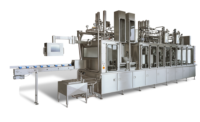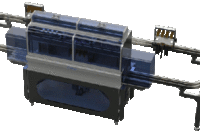Koch Membrane Systems (KMS), Wilmington, Mass., helped pioneer cross-flow membrane filtration for the industrial, food, water, chemical, environmental protection and biotechnology markets.
Many simple filtration processes use a dead-end technique - the flow of liquid to be filtered is directed perpendicular to the filter surface. This is effective when the concentration of particles to be removed is low or the packing tendency of the filtered material does not produce a large pressure drop across the filter medium. Some common examples of dead-end filtration are home water filters, vacuum cleaners and automobile oil filters. Typical industrial uses include the sterile filtration of water, beer and wine.
In contrast, there are many process streams that have high concentrations of particles or macromolecules such as cells, proteins and precipitates that will rapidly compact on the filter surface when operated in a dead-end mode. Consequently, the filtration rate drops quickly to an unacceptable level. In these instances, a cross-flow membrane system provides the means to maintain stable filtration rates. The key to the design of a cross-flow system is selecting a membrane geometry that suits the physical characteristics of the process fluid.
Cross-flow membranes can be provided in tubular, flat sheet, spiral wound and hollow fiber configurations, each of which provides certain advantages for specific process needs. Virtually any membrane design can be applied to water-like liquids with low concentrations of suspended solids, but viscous streams and fluids with large amounts of solids can only be handled with membranes specifically designed for this purpose. In general, the more difficult a stream is to process, the higher the cost of a membrane system and the higher the operating costs. Thus, an optimization study is an important component of any potential cross-flow installation.
The evolution of membrane technology
Modern cross-flow technology has primarily evolved during the past 40 years largely in step with the advancement of polymer chemistry. Durable, chemical-resistant polymers have made cross-flow technology cost-effective. Today, 98% of cross-flow installations utilize polymer-based membranes; inorganic materials such as ceramic are only selected in specific instances where pH, temperature or cleaning chemistry prohibit the use of polymers.
The theoretical principles of cross-flow filtration are derived from Fick’s law of diffusion, which addresses the migration of suspended solids/macromolecules in a flowing stream toward a filtration surface, and the potential back-diffusion into the bulk stream. This premise forms the basis for cross-flow design - that the concentration of macromolecules at the membrane surface can be controlled as a function of the velocity of fluid flowing parallel to that surface. The design of a successful cross-flow system relies on choosing a membrane geometry that can be installed and operated economically, provides consistent predictable results and can be effectively cleaned using chemicals compatible with the membrane.
The goal of membrane technologists is to use appropriate polymer material, module configuration, system design and operating conditions to achieve the most economical process possible. At the heart of this effort is the selection of a membrane with the optimum separation characteristics.
How is a specific membrane process defined?
Cross-flow membranes are manufactured in a range of porosities tailored to address various applications. These span the range of salt removal from water to large particulate filtration in viscous fluids. Filtration ranges have been defined that correlate to physical aspects of the membrane process and the relative size exclusion involved. In addition to the choices of polymer and membrane geometry, pore size selection is an integral part of process optimization.
The membrane with the smallest pores is reverse osmosis (RO), which involves, appropriately enough, reversal of the osmotic pressure of a solution in order to drive water away from dissolved molecules. Strictly speaking, RO is not a size-exclusion process based on pore size; it depends on ionic diffusion to effect the separation. A common application of reverse osmosis is sea water desalination, in which pure water is produced from a highly saline feed stream. In applications such as this, reverse osmosis serves a similar purpose to evaporation, yet provides better economics.
RO is also used in many industrial processes, including cheese whey concentration, fruit juice concentration, ice-making, car wash reclamation and wastewater volume reduction. In each of these examples, the goal is either to produce a pure filtrate (typically water) or retain the components of the feed stream as the product. Because the osmotic pressure (a measure of the dissolved ion concentration) of many process streams is quite high, RO membranes must be designed to operate at pressures of 400-1200 psi (29-83 bars), which restricts the available membrane geometries.
A natural extension of reverse osmosis is nanofiltration (NF) - the most recent development on the cross-flow frontier. NF functions similarly to reverse osmosis, but is generally targeted to remove only divalent and larger ions, hence the nickname for NF - selective rejection reverse osmosis. Monovalent ions such as sodium and chloride will pass through a nanofiltration membrane, thus many of the uses of NF involve de-salting of the process stream. An example is the production of lactose from cheese whey; the NF process is designed to concentrate the lactose molecules while passing salts - a procedure that purifies and concentrates the lactose stream. In water treatment, NF membranes are used for hardness removal (in place of water softeners), pesticide elimination and color reduction. Nanofiltration can also be used to reclaim spent NaOH solutions. In this case, the permeate (filtrate) stream is purified NaOH, thus allowing reuse many times over.
NF is also an osmotic pressure-dependent process, but due to the passage of monovalent ions, the net osmotic driving force required is less than RO. Operating pressures are lower and filtration rates are higher. Nanofiltration membranes typically operate in the range of 100-600 psi (7-42 bars). In many instances, NF can be used in place of RO.
Ultrafiltration (UF) is the next process on the pore size continuum. UF is not an osmotic process - the pores of UF membranes are larger and the method of rejection is primarily physical size exclusion. While RO/NF membranes are generally categorized by the degree of salt rejection under standard conditions, UF membranes are specified by a molecular weight cut-off rating (MWCO). The range of MWCOs for UF is generally considered to be 1,000-1,000,000 Daltons, which can be loosely correlated to pore size (roughly equivalent to 0.005-0.1 microns).
What is a Dalton?
Daltons are the scientific unit of measure of molecular weight, abbreviated Da. Daltons provide a method to precisely define the weight of a molecule based on an established standard - the carbon atom.
The Dalton is formally defined as 1/12 the weight of a carbon atom and is roughly equal to one proton. One Dalton weighs 1.066 x 10-24 grams. It is a convenient way of representing the weight of atoms and molecules.
The correlation between Daltons and microns is not exact because Daltons are a measure of 3-dimensional size based on atomic weight units and microns are a measure of 2-dimensional distance.
The major opportunities for UF involve clarification of solutions containing suspended solids, bacteria or high concentrations of macromolecules. These include oil/water separation, fruit juice clarification, milk and whey production, automotive electrocoat paint filtration, purification of pharmaceuticals, poly-vinyl alcohol and indigo recovery, potable water production and tertiary wastewater reuse.
UF membranes are manufactured in a much larger variety of configurations to address the wide range of applications. Many membrane geometries are available in part due to the fact that UF processes operate below 150 psi (10 bars) - some as low as 25 psi (2 bars).
The last sector that pertains to cross-flow technology is microfiltration (MF). MF is actually a hybrid, having its significant applications in simple dead-end filtration for water filtration, sterile bottling of fruit juices and wine and aseptic uses in the pharmaceutical industry. However, not all applications that benefit from the use of MF operate successfully in the dead-end mode; a large portion of the MF market has been captured by cross-flow.
The most common of these are clarification of whole cell broths and purification processes in which macromolecules must be separated from other large molecules, proteins and/or cell debris. Clarification of dextrose and highly-colored fruit juices employ MF extensively as well. There are also large markets for MF cross-flow filtration in wine production, milk/whey de-fatting and brewing. As with UF, MF systems operate at relatively low pressures and there are a variety of membrane configurations commercially available. Koch Membrane Systems (KMS), Wilmington, Mass., helped pioneer cross-flow membrane filtration for the industrial, food, water, chemical, environmental protection and biotechnology markets.
KMS is a leader in developing new membrane products and processes for liquid/liquid and liquid/solid separation and offers a wide range of state-of-the-art membrane elements as well as complete membrane systems specified for some of the most demanding applications.
About Koch Membrane Systems (KMS)
Koch Membrane Systems, Inc., Wilmington, Mass., has been a global leader in membrane filtration technology and engineering support for nearly half a century. KMS offers comprehensive process design, piloting and field service expertise. With an install base approaching 20,000 systems throughout the world, KMS is setting the standard as a comprehensive solutions provider for membrane technology. KMS is proud to be the Water Technology Company of the Year 2010.
For more information on Koch Membrane Systems and its full line of membranes and accessory products, visit www.kochmembrane.com.
Get our new eMagazine delivered to your inbox every month.
Stay in the know on the latest dairy industry trends.
SUBSCRIBE TODAYCopyright ©2024. All Rights Reserved BNP Media.
Design, CMS, Hosting & Web Development :: ePublishing

